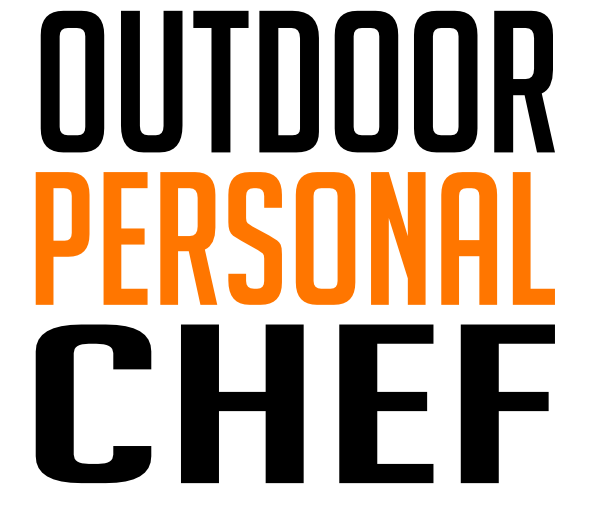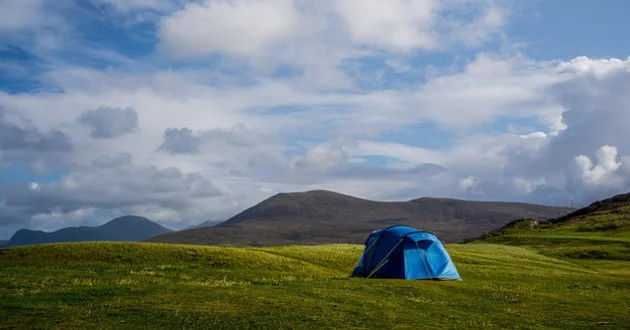Must-have items for camping include a cooking source, fuel, lighter, pots and pans. Including a water container, cookware, enough food and water for each person, plus one more and a clean-up kit is ideal. With these essential items, you can camp in any situation comfortably.
Cooking at a campsite should be something you look forward to and enjoy. It should be where you create most of your memories—cooking food for yourself or others over an open campfire or using a camping stove. I love camping outdoors because it lets me escape the stress of working in a busy kitchen.
As a Chef, food is very important to me and having the right equipment to make that job as easy as possible is just as important. In the following article, I have created a list of essential items I need for cooking at a campsite. I will give you some tips and ideas about things that can make your life easier while cooking at a campsite.
What do you need for cooking at a campsite?
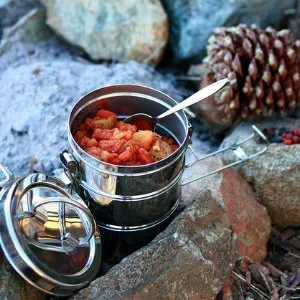
Here I will go through what I would use if I were camping in a managed public and wild campsite. The equipment you need will vary slightly, and it’s always good to see the difference between wild camping and managed camping site.
Wild Camping Campsite
Wild camping is what I love the most. I flourish the most by having your pack on your back with all the essentials you can carry. When wild camping, saving energy on packing light is essential but having the correct amount of food and equipment is also a top priority.
With wild camping, you tend to cut back on the more “luxury items” and scale your equipment and food back to save on weight. This doesn’t mean that you need to cut back on the quality of the food you can produce or carry. It means you must work smarter in what you choose to bring and cook.
When people think of wild camping, the first image that comes to mind is a roaring fire with a large pot over the flames cooking. This may be the dream, but in reality, most places won’t allow open fires because they are too dangerous or cause too much damage.
What you should use when wild camping is a small cooking stove for individual or group use. Ideally, each person should have their own method of cooking and carry their own food. For families, you can get bigger cooking stoves to will suit the whole family.
Butane gas is the way to go when wild camping. It’s small, efficient and lasts a lot longer with very little cleanup required afterwards. My go-to camping stove is my Trangia 25. This stove is for more than one person, but I like to bring it just in case I want to cook a larger meal for myself; hiking is hungry work. To learn more about both Trangia stoves, you can read my article on the Trangia 25 vs 27 camping stove for more information. I always prefer the trangia gas burner over the alcohol stove for the Trangia for control over the heat. Plus, alcohol stoves tend to give off soot which needs to be cleaned off your pots.
Public Campsite
When I say public campsite, I mean a campsite you pull up to in your car, pay a manager for a space to camp and set up for the night. You can afford to bring more equipment and food in these situations because you don’t have to hike it from your car to a far-off camping location.
Camping in a publicly managed campsite means you can afford to bring the more luxury items with you that make your camping trip feel like home, if that’s what you like.
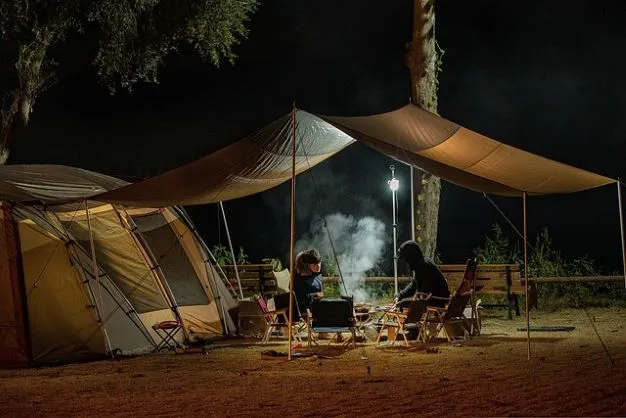
Since weight isn’t an issue, you can bring heavier cooking equipment, chairs, tables, a big cooler and cooking stoves. You have many more choices, which are great if this is the type of camping you like.
Camping in a managed campsite is perfect for those who want to experience camping and maybe have a few family members who may not be keen on giving up the luxury items they are accustomed to.
Some managed campsites will have a fire pit that you can use to cook over an open flame, or some may have a no-open fire policy. This is fine because you can always bring the bbq in the car or have a couple of portable stoves.
Essential Items for Cooking at a Campsite
The following list is what I consider the essential items for cooking at a campsite. This essential list goes for wild camping and managed campsites and can easily adapt to your needs.
1. Camp Stove/Cookware
The camp stove is the most important item you can choose for your camping trip. For camping in the wild, you are looking for something compact and light and with all the essential pots and pans required to cook your food. The food you cook will dictate what you should bring with you. If you are a boil-in-the-bag type, a stove with one or two pots will do. If like me, you love to cook food using fresh ingredients, you will need a cooking system with several options.
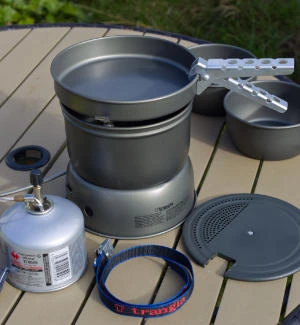
The best type of stove for wild camping is one that will allow you to nest items into each other to save space. This goes for if you are cooking ready-meals or fresh. Choosing a light camping stove that gets the job done is key. To see my personal recommendation and what I use, read my article in my Trangia Review.
For camping, you have many more options at a managed campsite. One of the best ways to cook is using an open fire, depending on the campsite’s rules. Most managed campsites will provide a fire pit if you use an open fire. Just check in advance if they do and if a grill is provided.
Cast iron pots and pans are perfect for cooking over an open fire as they really distribute the heat evenly. You can do so much with cast Iron, from getting a fantastic sear on a steak to using a dutch oven for baking; it depends on how adventurous you are. Normal pots and pans will do over and open fire also. It would be best if you were careful that they conduct heat well, as with campfires, you can’t control the temperature, so it’s easy to burn and scald your food.
Portable gas stoves are also ideal for camping in a managed campsite. A multi-burner portable stove will allow you to cook several meals at once, perfect for family camping trips. With a portable stove, you can skip cast Iron and choose a heavy-based stainless pot or non-stick pan instead.
2. Fuel
The fuel you bring will vary depending on what type of camping you are doing. If you are going wild camping, bringing a lightweight gas canister or spirit stove will save space while providing you with enough fuel for all your cooking and heating needs.
I wrote an article on the how to light a camping stove if you would like to learn more.
Camping in a managed camp, you can bring a bigger gas canister, charcoal if you have a bbq or wood if you have an open fire. I wouldn’t bother with spirit stoves if you are camping in a managed campsite as the benefits they provide while wild camping is not worth it when you can choose something better. Spirit stoves tend to cook food slower, and large amounts of food require refilling regularly.
3. Cooking Utensils
For wild camping, you want to keep the cooking utensils you carry to a minimum and have them as light as possible while also being functional. You have to plan and think about what food you will be cooking. If you are cooking boil-in-the-bag food, you probably won’t need a plate, but you will need a long fork or spoon to stir the food and reach into the bag. If cooking fresh, again, you may not need a plate or bowl as you can always eat out of the pan or pot; it’s what I normally do.
I will normally carry the cooking utensils a long-handled spoon, some chopsticks (fantastic for whisking, turning food and eating noodles) and a silicone spatula. I will also normally carry a small foldable knife just in case I need it. I normally cut and prepare as much as possible at home before camping; it’s what I would do in a professional kitchen. I have an article on if have a camping knife is necessary for camping, which I think you will enjoy.
For a managed campsite, go all out. Get yourself a picnic set with cutlery, plastic plates, cups, and a blanket. You want cooking utensils to add comfort and value to your camp trip. Along with your cutlery and plates, bring some cooking tongs (click twice before using, it’s what all professional chefs do), a silicone spatula and a good quality knife.
4. Food
The food you bring with you for camping should be what you enjoy eating. You see many people going out camping, bringing a boil-in-the-bag meal because they want something in them. This is fine if all you want is to fill your belly, but I prefer to enjoy my food while having something good and nourishing in my belly.
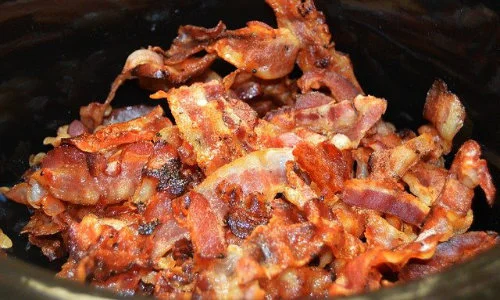
In wild camping, you need to carry enough food and a little extra for emergencies. Try to prepare as much as possible at home before leaving, cutting veg, cooking meats and bagging up ingredients. Doing this will save you time, is safer than using a knife out in the middle of nowhere, and saves you fuel.
Managed camping sites, you have more options, and weight won’t limit you. I would still cut and prepare as much as possible from home before you get to your camping site because cooking food is a better process, and you can enjoy your meal faster. You don’t need to bring emergency food as your car is nearby if you need it.
Choose the food to suit your cooking process. If you have a one-pot system, you will need to go with simple meals that you can put into one pot and cook. If you have multiple pots or burners, you have more options in the type of meals you can prepare and cook.
I have an article on foods that keep well for camping which you might like to read.
5. Heatproof Gloves
Whether wild camping or managed campsite camping, a good pair of heatproof gloves is essential. Burning yourself while camping is never great, especially if you are wild camping. If you get a bad burn, you will need plenty of cool water to treat the burn, apply cooling gels, and tend to the burn. Bring a pair of heatproof gloves to minimise the chances of burning yourself.
6. Collapsible Water Container
Besides food, you will need water to drink, cook and clean. Having a portable collapsible water container is perfect for all types of camping.
In wild camping, you will collect your water from a flowing water source, boil, filter or chemically treat to make it drinkable.
If you are In a managed camping site, inquire if they have mains water available, they normally do.
7. Cool Box
A cool box, in my opinion, can fall into the luxury item list. For wild camping, I tend to precook my meats before leaving home, but if I needed to bring raw, I would use an insulated flask or a container with some ice packs.
You can get a big cooler box at the managed campsite, fill it with ice, or use a mains or battery-powered cool box to store all your drinks and food. Having your car nearby allows you to power a coolbox at your campsite easily and gives you more options for storing and cooking meals.
8. Clean-up Kit
Your clean-up will be the same for both wild and managed campsite camping.
Bring refuse bags to store any rubbish you have. Always operate on leave no trace policy regardless of where you are camping. You want people to enjoy the outdoors, so always leave your campsite as you would to find a campsite, in perfect condition.
Bring a washing-up kit that contains a microfiber cloth, eco-friendly washing-up liquid (don’t use home washing-up liquid, it’s not nice for outdoor environments) and a scouring pad. This will get all your cooking items clean and clear so you can pack them away after use. Keeping food equipment clean will reduce the chances of catching food-related illnesses, which is a very important step.
A Personal hygiene kit is essential for camping. This can contain a toothbrush and toothpaste (try charcoal, it’s better for outdoor use), a microfiber cloth, towel, and soap. Washing outdoors is invigorating, especially on cooler nights. Cleaning yourself with hot water and seeing the steam in the evening or night makes you feel human. You also tend to sleep better in a fresh and clean sleeping bag.
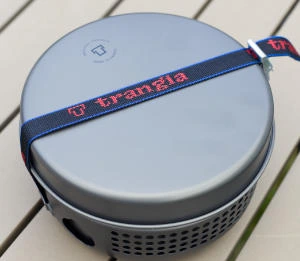
9. Camping Extras
A personalised first aid kit is one extra item I will always carry outdoors. You can bring a first-aid kit for your whole family if you like, but I always carry a first-aid kit specifically built for me and my personal use. This will include plasters, blister tape, burn cream, headache pills, triangular bandages, scissors, tweezers, and antiseptic wipes. For more info on what should go into a first aid kit, Tresspass.com have a fantastic article with more information.
Building your first aid kit is important, as taking care of your personal needs is a priority because if you can’t take care of yourself, you won’t be able to care for others.
Mobile phone charger can come in the form of a power bank, or if you have a car, don’t forget to pack our charging cable.
Radio is perfect for entertaining yourself through the night. Pack a lightweight, battery-operated camping radio, or you can wind to power.
A water filtration system is always a good idea if you use untreated water. You can use chemical methods to treat your water or even boil it. I normally carry a small pouch to attach a mini filter and force the water into a drinking container.
Summary
What you need to cook at a camping site will always have some key components you will always need to bring. What changes is if you must carry that equipment long or short distances.
Camping outdoors should always be a fun and enjoyable experience. Food should be an important part of camping outdoors, and most of your memories will be of eating a delicious hot meal while staring into the night sky or looking out over fields, lakes and rivers.
Bring the right cooking equipment to cook in a campsite and start creating memories that will last a lifetime.
Outdoor Personal Chef is a participant in the Amazon Services LLC Associates Program, an affiliate advertising program designed to provide a means for sites to earn advertising fees by advertising and linking to Amazon.com. We also participate in other affiliate programs which compensate us for referring traffic.
